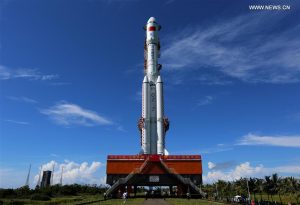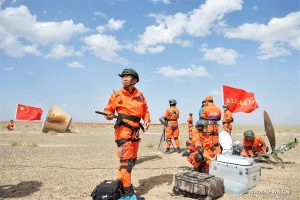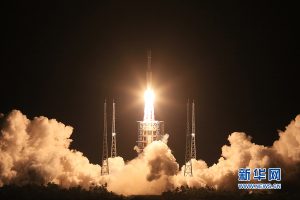China’s space program has a pretty packed schedule ahead of it. After announcing an aggressive five-year space plan earlier this year, it’s making good on that outline with the July 25th launch of a new rocket into space.
The 174 feet (53.1 meters) tall Long March-7 took off at 8pm local time at the Wenchang Satellite Launch Center. For its inaugural flight, the rocket carried a miniature version of China’s forthcoming crew capsule as well as several small satellites.
“With the improvement of the rocket’s technological performance, the Long March-7 will step by step replace the current carrier rockets and become the main carrier for space launches,” said Wu Ping, deputy director of the manned space engineering office, at a press conference following the launch.
The Long March-7 now takes the record as the most powerful rocket ever built in China, with the ability to carry nearly 30,000 pounds into low Earth orbit. It will become China’s main workhorse rocket as the country continues to expand its space program, one that includes such ambitious goals as launching a new space station, making more moon landings, and even sending an unmanned probe to Mars in 2020.
According to Yang Baohua, deputy manager of China Aerospace Science and Technology Corporation (CASTC), the country expects to get more than 200 spacecraft in orbit by 2020 and perform about 30 launches per year on average.

The new rocket launch was an incremental upgrade for China’s space program in many ways. For one, the Long March-7 ran on rocket-grade kerosene and liquid oxygen. Already widely used in Russia and the US, the new mix is far more environmentally friendly than the previous toxic cocktail of hydrazine and nitrogen tetroxide propellants.
The rocket’s launch site also made its debut for this flight. The Wenchang site sits farther South and closer to the equator than any other site used in China. This allows it to take better advantage of Earth’s spin rate and put heavier satellites into orbit. Its proximity to the South China Sea also allows it to drop spent rocket stages directly into the water.
The Long March-7 just is one of a trio of rockets intended to replace China’s predecessor fleet. The smaller Long March-6 was first launched September last year and will jettison small satellites into low-altitude orbits. Meanwhile, the larger Long March-5 will debut later this year and will be used for heavier missions.
Adding to the already crowded calendar of events, China will launch its second space lab into orbit. The Tiangong-2 will launch in September and replace the now defunct Tiangong-1. Then the country will round out the year with a two-person mission to visit Tiangong-2 for 30 days.
After a 20-hour orbit, the Long March-7’s reentry module landed in the Badain Jaran Desert in Inner Mongolia on Sunday. It was quickly picked up by technical personnel and delivered to the China Academy of Space Technology in Beijing.












